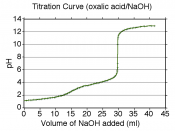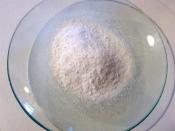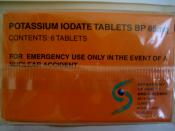IMMNAUEL LUTHERAN COLLEGE
S6 Chemistry Name: Hramar ( 7 )
Experiment 7 : Analysis of commercial vitamin C tablet
Title: Determination of the vitamin C content (ascorbic acid) of a commercial vitamin C tablet and compare the result with the value specified by the manufacturer.
Theory :
In this experiment, we have to determine the vitamin C content of a commercial vitamin C tablet which is the mass of ascorbic acid in the tablet. As iodine is a weak oxidizing agent used mainly for the determination of strong reducing agents, ascorbic acid C6H8O6 (aq) can be rapidly and quantitatively oxidized by iodine in acidic condition as shown in the following equation:
I2(aq) + C6H8O6 (aq) â C6H6O6 (aq) + 2H+ (aq) + 2I- (aq)
This method involves the direct titration of the ascorbic acid with a standard iodine solution in an acidic medium. However, iodine is not very soluble in water (0.001M),
this makes the method less than ideal.
Instead of dissolving solid iodine in water, we can obtain excess quantity of iodine solution by adding an unmeasured excess of potassium iodide solution to a known volume of an acidified standard potassium iodate solution according to the following equation:
IO3-(aq) + 5 I- (aq) + 6 H+ (aq) 3I2 (aq) + 3H2O (l)
Then the experiment is immediately followed by a back titration of the excess liberated iodine with standard sodium thiosulphate solution as shown below:
I2 (aq) + 2S2O32- (aq) â 2I- (aq) + S4O62- (aq)
With iodine solution, the thiosulphate ion is oxidized quantitatively to tetrathionate ion. The amount of iodine solution produced using this method can then be calculated.
The above method have to be repeated for two times. The first time without the ascorbic acid, but the second time with. By finding out the amount of...


